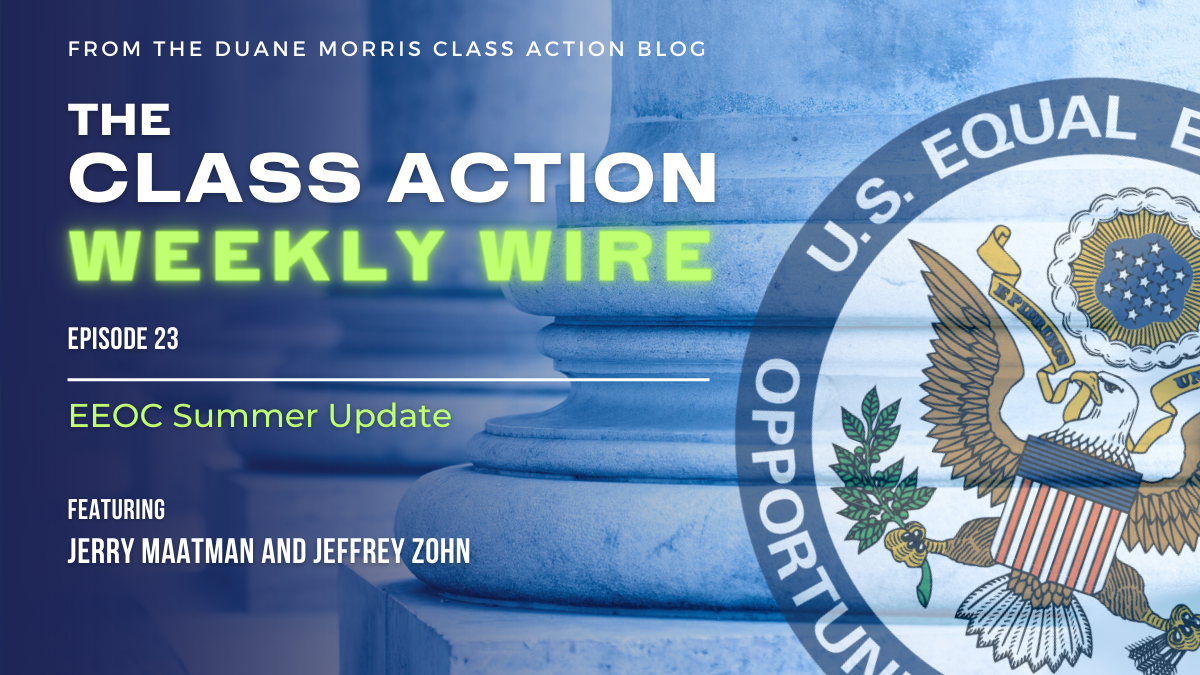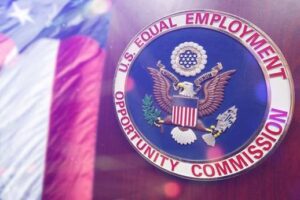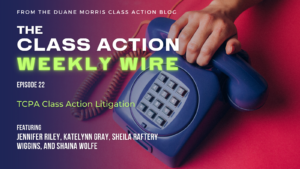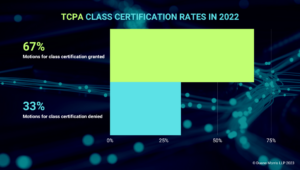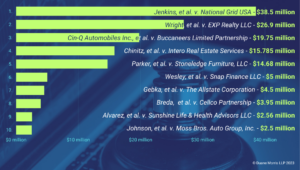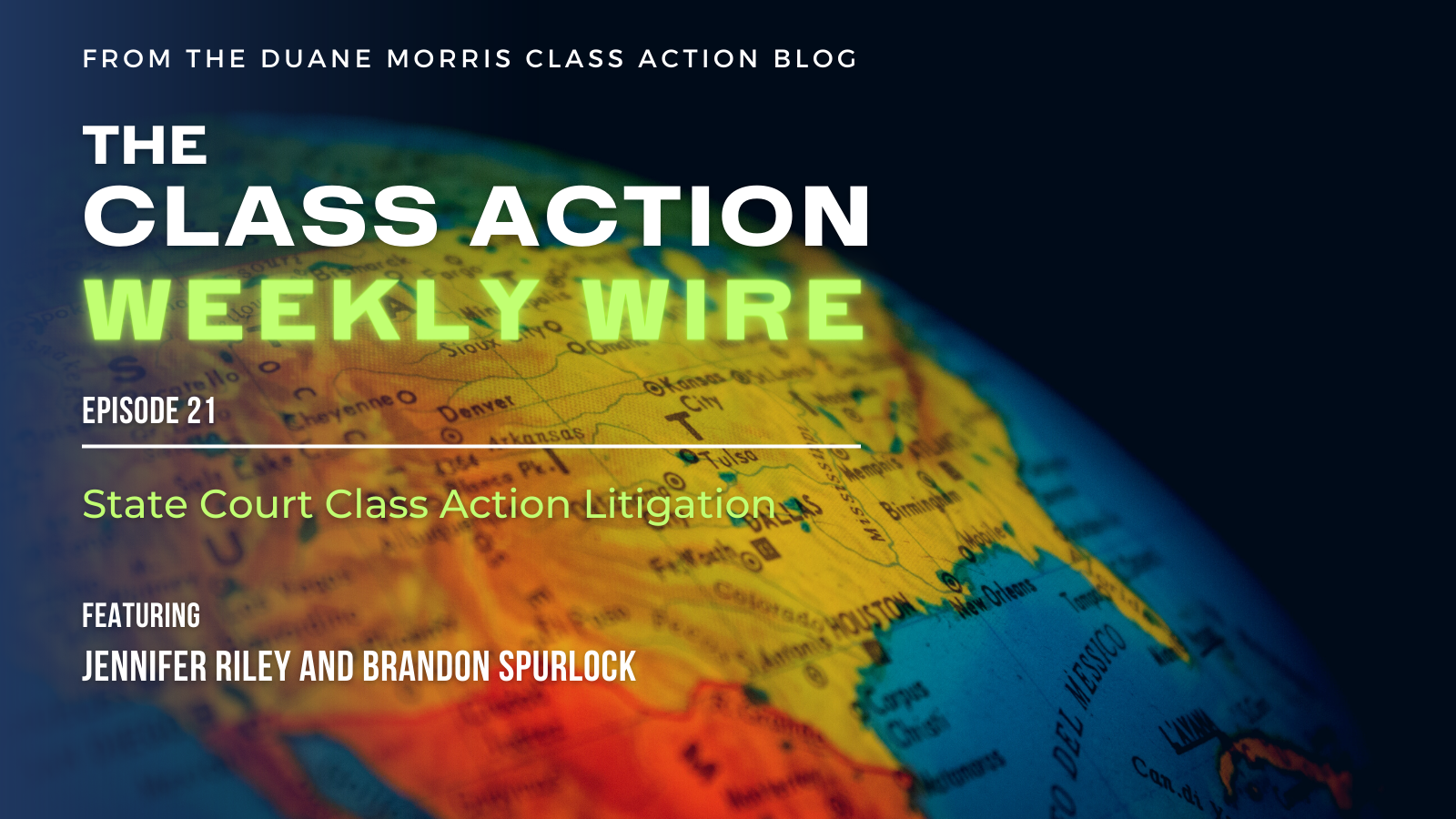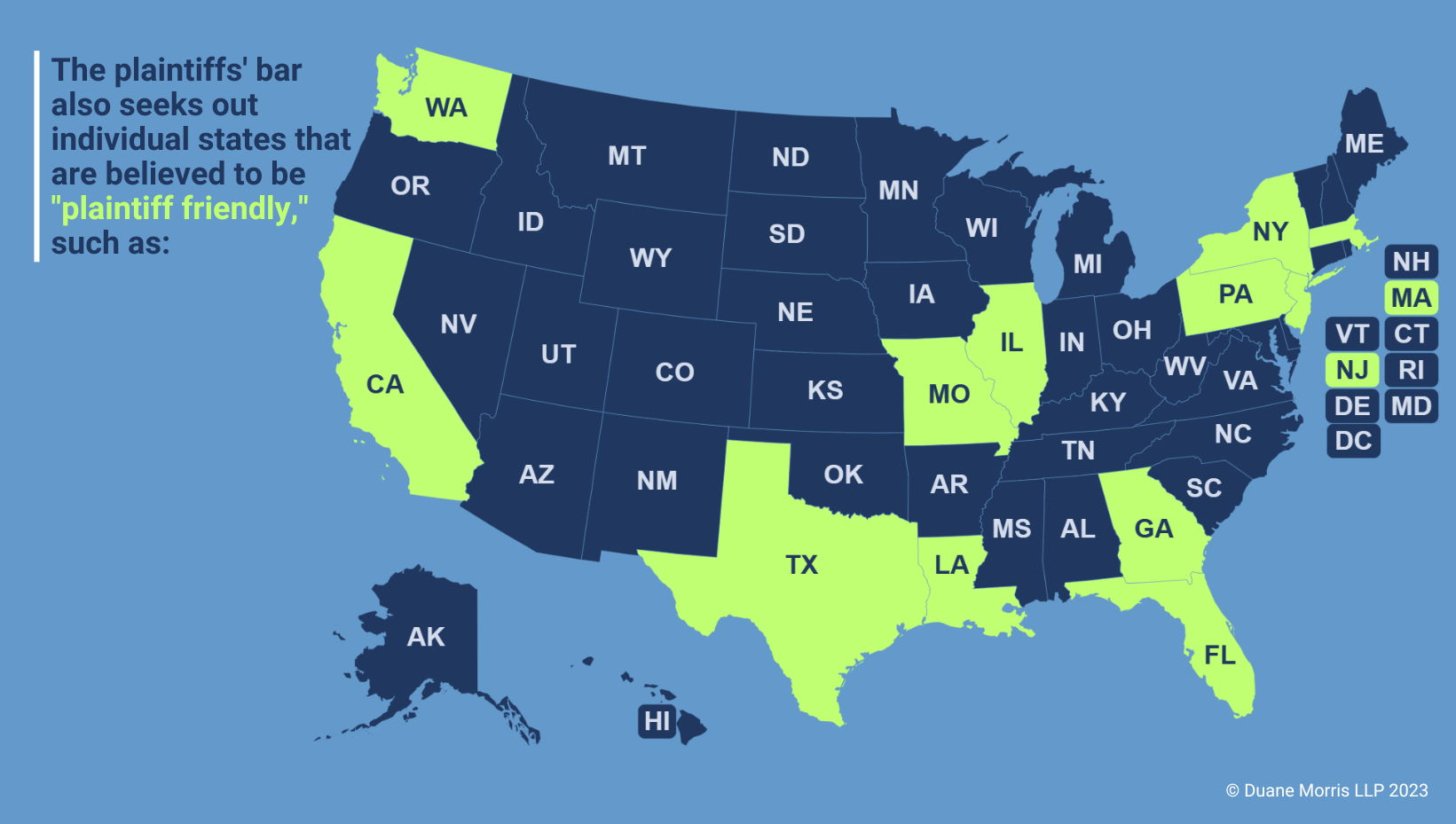Duane Morris Takeaway: This week’s episode of the Class Action Weekly Wire features Duane Morris partner Jerry Maatman and associate Jeffrey Zohn with their discussion of recent developments at the EEOC including the Commission’s current enforcement priorities, the nomination of Kalpana Kotagal as the new commissioner, and what employers can expect under the current leadership structure.
Episode Transcript
Jerry Maatman: Blog readers, welcome to our Friday installment of the Class Action Weekly Wire. My name is Jerry Maatman of Duane Morris and I’m joined today by my colleague, Jeffrey Zohn, for this week’s episode. Welcome, Jeff!
Jeffrey Zohn: Thanks, Jerry. It’s great to be here, and I’m especially honored to be here because in today’s episode we get to mix it up where I got to interview you and ask you some questions about what’s going on with the Equal Employment Opportunity Commission, also known as the EEOC.
Jerry: Sounds good, fire away with those questions.
Jeff: All right so we’ll start out with an easier one for you – can you first explain about how the EEOC is structured in terms of its governance – who’s in charge, and how can one become part of the EEOC leadership?
Jerry: The EEOC is a creature of statute, it is in theory to be a bipartisan commission with leadership consisting of a chair, a vice chair, and three commissioners – and those five set policies for the EEOC, approve policy statements and enforcement guidance. A general counsel is also appointed by the President and reports to those commissioners, and typically the party in power that holds the White House will have a three to two advantage in terms of the composition of the five – the chair, the vice chair, and the three commissioners.
Jeff: Now of those five commissioners, are they all currently in place?
Jerry: Well, the EEOC has been dealing, like many government agencies, with recovering from the pandemic and from the election and so it has been operating for quite a while with only four commissioners – two Republicans and two Democrats. Although the EEOC and public pronouncements would not say things are deadlocked, people looking at the EEOC from the outside would suggest that there is an ideological deadlock with two Republican policy makers not agreeing with two Democratic policy makers, but in the last two weeks the Senate approved President Biden’s nomination of the fifth commissioner Kalpana Kotagal – she has yet to be sworn in, but will be sworn in any day now, and that will then allow the EEOC to have a full complement of policy makers and the five Commissioners, and will tip the balance in favor of kind of Democratic views of the policies and enforcement guidance memorandum of the EEOC.
Jeff: That sounds like a major development and something that could possibly bring some pretty significant changes to the EEOC.
Jerry: For employers it’s definitely, in the practical world in which we live, going to have a cause and effect that’s very different than what we’ve seen for the last two years, I think on several levels. The first level will be the issuance of policy guidance where the EEOC opines on how it interprets various statutes – and with a three to two majority with the Democrats, in my experience, what I’ve seen are very expansive interpretations of obligations that employers have under anti-discrimination laws and a broadening of the way the EEOC views rights of workers. Its views are not binding on federal courts, but its views are important, and its views activate the manner in which its investigators, district offices, and regional trial attorneys view the world and enforce the statute – and so there’s going to be a definite change, and the EEOC will act in a more activist manner to fulfill its policy mandates but it will do so with a tilt towards Democratic labor policies.
The second area where there will be a change most commentators believe, and I’m of the same opinion, that lawsuits – or investigations that have been in the queue for approval as lawsuits – will be approved and will begin to be filed. So the last couple of years EEOC-authorized lawsuits where the Commission sues in the public interest, on behalf of the United States against employers, on behalf of groups of employees – have been anywhere between about 85 and 105 lawsuits, and so its fiscal year starts on October 1 and goes to September 30. So we’re halfway through or a little past halfway through in the fiscal year, but I think what we’re going to see is an accelerated filing of lawsuits – especially what are known as systemic lawsuits that are bigger, brought on behalf of various groups of employees, hundreds sometimes thousands of employees, and so one way to look at the impact of the third Democratic commissioner is it will unleash the potential that the EEOC has in terms of litigation enforcement and I expect it to flex its muscle and bring more of those cases.
Jeff: So narrowing in a little bit more on Ms. Kotagal, the fifth appointment, the third Democrat – Jerry you’ve been one of the most distinguished lawyers in this field for a while, can you give us any background information on her?
Jerry: Well she is a very talented lawyer who also thinks expansively about this area and has handled big plaintiff-side employment discrimination class actions, she comes from the Cohen Milstein firm – probably one of the best if not the top plaintiff-side civil rights and employment discrimination law firm – she’s one of the key partners there. I’ve handled a myriad of cases against her, she’s an excellent lawyer, and has in the past few years been involved in movements: both the #MeToo movement and a movement that started in Hollywood, where Hollywood contracts for production of movies were created with a clause that would allow for hiring and use of a more diverse set of cast members and production personnel, and so she’s very interested in opening the doors of employment, she’s interested in bringing test cases to challenge policies, and she’s a champion of protected minority groups – so I expect her to utilize her expertise and bring it to the EEOC and to push the envelope, so to speak, in terms of what the EEOC does in enforcing employment discrimination laws
Jeff: It certainly sounds like her influence is going to be is going to be rapid and significant.
Jerry: I think so. I think the main thing on the EEOC’s agenda in terms of regulatory guidance will be the new Pregnant Workers Fairness Act where the EEOC will issue regulations and fill in the gaps, so to speak, of that law which is an amendment to the Pregnancy Discrimination Act that President Biden signed this year, and look for that to be kind of a signal of where the EEOC is going, and I expect it will be a very expansive document that will push the envelope even on that law to create more rights for workers who are pregnant and more obligations for employers – so that would be the first signal I would be looking for if I were an employer.
Jeff: Beyond that, are there any other EEOC developments that you think are worth talking about right now?
Jerry: I think the most relevant for most employers is the issue of systemic litigation that the EEOC has talked about it, but the number of systemic lawsuits that have been filed have been limited, and because the new commissioner’s background is on what I would call impact litigation, bringing cases to promote change, I think you’re going to be seeing test cases I think you’re going to be seeing cases brought on large against large employers, industry leaders to try and make a point and try and enforce the statute in a way that sends a signal to smaller players in the industry. So I think the EEOC is going to get back into the business of bringing large lawsuits against large employers that are very newsworthy.
Jeff: I think that should be the flashing red lights for the big companies to keep an eye on because that’s going to be impacting them directly. Definitely now is a great time for employers out there to make sure that they are compliant with all these requirements and the things that we think the EEOC is going to be going after.
Jerry: Absolutely, I think change is inevitable and the watchword is compliance compliance compliance is what employers need to be focused on at this point in terms of an activist EEOC.
Jeff: That is definitely a great advice, and I really appreciate all of the insights you had today, Jerry.
Jerry: Thanks all our loyal blog readers for joining us for this week’s Friday podcast. Signing off, this is Jeff and Jerry. Have a great day
Jeff: Bye everyone, thank you!

